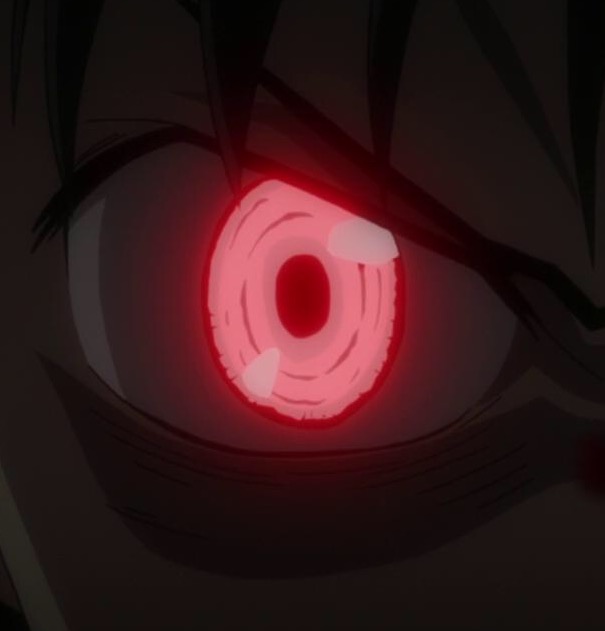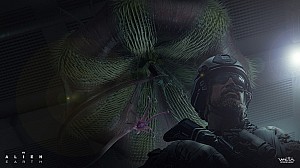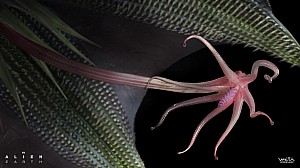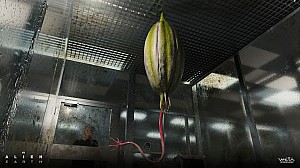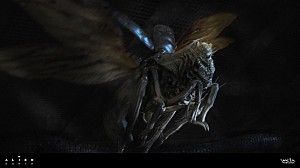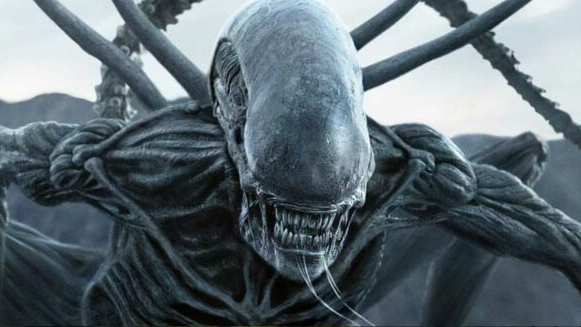JAMES CAMERON is the writer/director of ALIENS. Previously, he co-wrote (with Gale Anne Hurd) and directed Terminator. His first film as director was Piranha II: The Spawning. Cameron's other filmmaking credits include Rambo: First Blood II (as co-writer), Battle Beyond the Stars (as art director), Escape from New York (as special FX co-supervisor) and Planet of Horrors (as production designer/second unit director). Interviews with Cameron have appeared in STARLOG #89 & 110 and FANGORIA #56. A previously unpublished Cameron interview, conducted after ALIENS' release, appears in THE BLOODY BEST OF FANGORIA f6. This essay, Cameron's reply to readers' letters on ALIENS, was addressed to the Communications department but is published here as part of the ongoing SF professionals' forum, Other Voices. by James Cameron.

As the writer and director of ALIENS, I naturally prefer the sort of cogent criticism contained in Lisa Snyder's letter (STARLOG #116) stating "ALIENS is perfect!" However, since there were 11 other letters in the same issue containing complaints of flaws in logic, accuracy and aesthetic execution, I thought I would take this opportunity to reply en masse.
I will take them in the order they were printed. First, Peter Briggs, who seems otherwise to be a fairly well-researched student of ALIEN, points out incorrectly that "LV-4ticias a ringed planet." The unnamed planetoid harbouring the alien derelict ship, to which I gave the designation LV-426, was, in fact, a moon of a ringed gas giant, which was occasionally glimpsed in the sky in ALIEN. The gas giant does not appear in ALIENS because the exterior scenes on LV-426 have an unbroken cloud cover or overcast, and the space scenes are handled in a cursory manner, advancing the story without dwelling on the wonders of interstellar travel, which so many other films have done so well, as their primary raison d'etre. You might say we approached LV-426 from the other direction, and the ringed gas giant companion was out of frame.
Briggs' next problem was "Why do the colonists not pick up the derelict SOS?" by which I assume he is referring to the acoustic beacon broadcasting a "warning." As some readers may know, scenes were filmed but cut from the final release version of the film which depicted the discovery of the derelict by a mom-and-pop geological survey (i.e.: prospecting) team. As scripted, they were given the general coordinates of its position by the manager of the colony, on orders from Carter Burke. It is not directly stated, but presumed, that Burke could only have gotten that information from Ripley or from the black-box flight recorder aboard the shuttle Narcissus, which accessed the Nostromo's onboard computer. When the Jorden family, including young Newt, reach the coordinates, they discover the derelict ship. Since we and the Nostromo crew last saw it, it has been damaged by volcanic activity, a lava flow having crushed it against a rock outcropping and ripped open its hull. Aside from considerations of visual interest, this serves as a justification for the acoustic beacon being non-operational.
Briggs' idea that the company had already discovered the derelict is, therefore, unnecessary and would invalidate Carter Burke's motives for attempting to bring back a sample of the organism for study, and using such drastic means to do it.
The missing scenes also provide a more solid connecting link in the process of the colony's infestation. We see Russ Jorden dragged back to their vehicle by his wife with a "facehugger" parasite attached to his face. We see the wife call the colony for a rescue party. It's fairly simple extrapolation to assume that the progress of the organism through the enclosed and isolated population of the colony followed much the same course, on a greater scale, as the life cycle of the original Alien on board Nostromo.
These scenes, as well as four or five others, which would certainly be of interest to fans, will be restored for the ABC airings of the film and, if all goes well, in a "special edition" videocassette, running roughly 12 minutes longer than the release of 137 minutes. No confirmed release date is set for either of these, but stay tuned.
Briggs' next beef is with the Alien Queen, and for several reasons. His contention is that she destroys the original intention of the missing scene in ALIEN. This is perfectly correct, but I find it somewhat irrelevant since as an audience member and as a filmmaker creating a sequel, I can really only be responsible for those elements which actually appeared in the first film and not to its "intentions." ALIEN screenwriter Dan O'Bannon's proposed life cycle, as completed in the unseen scene, would have been too restricting for me as a storyteller and I would assume that few fans of ALIENS would be willing to trade the final cat-fight between the moms for a point of technical accuracy that only a microscopic percentage of ALIEN fans might be aware of.
In my version of the Alien life cycle, the infestation of the colony would proceed like this:
1. Russ Jorden attacked, they radio for rescue.
2. Rescue party investigates ship...several members facehuggered... brought back to base for treatment.
3. Several "chestbursters" free themselves from hosts, escape into ducting, begin to grow.
4. Extrapolating from entomology (ants, termites, etc.), an immature female, one of the first to emerge from hosts, grows to become a new queen, while males become drones or warriors. Subsequent female larvae remain dormant or are killed by males... or biochemically sense that a queen exists and change into males to limit waste. The Queen locates a nesting spot (the warmth of the atmosphere station heat exchanger level being perfect for egg incubation) and becomes sedentary. She is then tended by the males as her abdomen swells into a distended egg sac. The drones and warriors also secrete a resinous building material to line the structure, creating niches in which they may lie dormant when food supplies and/or hosts for further reproduction become depleted (i.e. when all the colonists are used up). They are discovered in this condition by the troopers, but quickly emerge when new hosts present themselves.
Thus, even with the Queen's vast egg laying capacity, the Aliens are still a parasitic form, requiring a host from a different species to create the warrior or Queen stages of the life cycle. Since the warriors are bipedal with two arms (H.R. Giger's original design), it may be inferred that the facehugger is an indifferentiated parasite, which lays an egg inside a host, but that the resulting form (chestburster through adult) has taken on certain biological characteristics of its host. This would account for the degree of anthropomorphism in the design.
One admittedly confusing aspect of this creature's behaviour (which was unclear as well in ALIEN) is the fact that sometimes the warrior will capture prey for a host, and other times, simply kill it. For example, Ferro the dropship pilot is killed outright while Newt, and previously most of the colony members were only captured and cocooned within the walls to aid in the Aliens' reproduction cycle. If we assume the Aliens have intelligence, at least in the central guiding authority of the Queen, then it is possible that these decisions may have a tactical basis. For example, Ferro was a greater threat, piloting the heavily armed dropship, than she was a desirable host for reproduction. Newt, and most of the colonists, were unarmed and relatively helpless, therefore easily captured for hosting.
Please bear in mind the difficulty of communicating a life cycle this complex to a mass audience, which, seven years later, may barely recall that there was an Alien in ALIEN, let alone the specifics of its physical development. I had a great deal of story to tell, and a thorough re-education would have relegated ALIENS to a pedantic reprise of Ridley Scott's film. The audience seems to have a deep-seated faith in the Aliens' basic nastiness and drive to reproduce which requires little logical rationale. That leaves only hardcore fans such as myself and a majority of this readership to ponder the technical specifics and construct a plausible scenario.
Kelly Godel deplores the Aliens as "lame, weak and shameful follow-ups to their predecessor." A careful analysis of both films would show that the adult warrior (my term for the single adult seen in ALIEN) has the same physical powers and capabilities in ALIENS as it did previously. Since the Nostromo crew were unarmed, with the exception of flamethrowers (which we never see actually used against the creature), the relative threat was much greater than it would be to an armed squad of state-of-the- art Marines. One, crazed man with a knife can be the most terrifying thing you can imagine if you happen to be unarmed and locked in a house alone with him. If you're with 10 armed police officers, it's a different story.
We set out to make a different type of film, not just retell the same story in a different way. The Aliens are terrifying in their overwhelming force of numbers. The dramatic situations emerging from characters under stress can work just as well in an Alamo or Zulu Dawn as they can in a Friday the 13th, with its antagonist.
Jim Ficken discusses plot lines for ALIEN III but I can't comment, since Gale Hurd, the producer of ALIENS, and myself have decided to move on to other things and leave a third film to others.
Ben Smith asks where the Aliens originated. In dialogue, I have Ripley specifically telling a member of the inquiry board, "I already told you, it was not indigenous, it was a derelict spacecraft, an alien ship, it was not from there." That seems clear enough. Don't ask me where it was from... there are some things man was not meant to know. Presumably, the derelict pilot (space jockey, big dental patient, etc.) became infected en route to somewhere and set down on the barren planetoid to isolate the dangerous creatures, setting up the warning beacon as his last act. What happened to the creature that emerged from him? Ask Ridley. As to the purpose of the Alien... I think that's clear. They're just trying to make a living, same as us. It's not their fault that they happen to be disgusting parasitical predators, any more than a black widow spider or a cobra can be blamed for its biological nature.
David R. Larson makes some interesting comments and yes, the design of the "warrior" adult was altered slightly. His rationale for this is as good as mine (that the individual in ALIEN never reached maturity).
Daniel Line asks more questions about the derelict which, as a writer, I could provide plausible answers for, but they're no more valid than anyone else's. Clearly, the dental patient was a sole crew member on a one-man ship. Perhaps his homeworld did know of his demise but felt it was pointless to rescue a doomed person. Perhaps he was a volunteer or a draftee on the hazardous mission of bio-isolating these organisms. Perhaps he was a military pilot, delivering the alien eggs as a bio-weapon in some ancient interstellar war humans know nothing of, and got infected inadvertently. "How could the man who went onto the derelict not know something was wrong when he saw the dead gunner?" Well, Dallas, Kane and Lambert saw the dead gunner and that didn't stop them. Human curiosity is a powerful force. As for the equipment left behind by the Nostromo crew being a deterrent, this requires that Jorden and the other colonists enter the derelict through the Freudian main door. In ALIENS gong version), they enter through a large rent in the hull caused by damage from the lava flow, going directly into the egg chamber level.
Abbas Rezvi takes exception to Ripley's ease of adjustment to 57 years of technological change. First of all, ask yourself if an intelligent and willful person from 1930 could or could not adapt to the technology of 1987, given a few months of training. They had automobiles (including traffic jams), machine guns and aeroplanes then, only the specifics are different now. Conversely, however, who could have dreamed of the impact of computers and video on our current environment? A second point is that there have been 57-year periods in history where little or no social or technological change took place, due to religious repression, war, plague or other factors. Perhaps technology had topped out or plateaued before the Nostromo's flight, and the changes upon Ripley's return were not great. You decide. It doesn't bother Ripley, and it doesn't bother me. I hope this answers a few of your readers' concerns. I would like to thank STARLOG for its support of our film through articles ("Viva Vasquez"), movie books, etc. We'll keep you posted on upcoming projects, several of which are science fiction.
By the way, it's not in the goddam cat and it's not in Newt, either. I would never be that cruel.

David Giler: Cinefantastique Interview
David Giler, who wrote scripts for MYRA BRECKINRIDGE, THE PARALLAX VIEW and FUN WITH DICK AND JANE, always seemed to get his office located down the h...

David Giler Alien 3 Starburst Special Interview October 1992
Alien 3 screenwriter David Giler guides us on the terrifying journey from script to screen. Why was there a third Alien movie? What were all the re-wr...

Did Alien 3 rip-off The Element of Crime?
In 1984, Danish filmmaker Lars von Trier (Melancholia, Dogville) began his directorial career with The Element of Crime, his first feature film. ...







